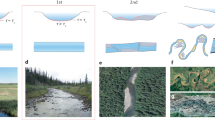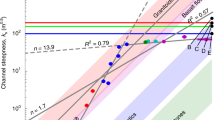Abstract
The re-emergence of groundwater at the surface shapes the Earth’s topography through a process known as seepage erosion1,2,3,4,5. In combination with flow over land6, seepage erosion contributes to the initiation and growth of channel networks1,2,3,4,5. Seepage processes have also been invoked in the formation of enigmatic amphitheatre-headed channel networks on both Earth7,8,9,10,11 and Mars12,13,14. However, the role of seepage in producing such channels remains controversial11,15,16. One proposed growth law for channel development suggests that the velocity at which channel heads advance is proportional to the flux of groundwater to the heads17. Here we use field observations and physical theory to show that this simple model, combined with a second linear response that relates channel branching to the total groundwater flux to the network, is sufficient to characterize key aspects of the growth and form of a kilometre-scale seepage-driven channel network in Florida18. We find that the dynamics for the advance of channel heads are reversible, which allows us to estimate the age of the channel network and reconstruct the history of its growth. Our theory also predicts the evolution of the characteristic length scale between channels19, thereby linking network growth dynamics to geometric form.
This is a preview of subscription content, access via your institution
Access options
Subscribe to this journal
Receive 12 print issues and online access
$259.00 per year
only $21.58 per issue
Buy this article
- Purchase on Springer Link
- Instant access to full article PDF
Prices may be subject to local taxes which are calculated during checkout




Similar content being viewed by others
References
Dunne, T. Runoff Production in a Humid Area. Thesis (Johns Hopkins Univ., 1969). Also published as US Department of Agriculture Report ARS 41–160 (1970).
Dunne, T. in Hillslope Hydrology (ed. Kirkby, M. J.) 227–293 (Wiley, 1978).
Dunne, T. Formation and controls of channel networks. Prog. Phys. Geogr. 4, 211–239 (1980).
Dunne, T. in Groundwater Geomorphology: The Role of Subsurface Water in Earth-Surface Processes and Landforms Vol. 252 (eds Higgins, C. G. & Coates, D. R.) 1–28 (Geol. Soc. Am. Special Paper, Geological Society of America, 1990).
Dietrich, W. E. & Dunne, T. in Channel Network Hydrology (eds Beven, K. & Kirby, M. J.) 175–219 (Wiley, 1993).
Horton, R. E. Erosional development of streams and their drainage basins: Hydrophysical approach to quantitative morphology. Geol. Soc. Am. Bull. 56, 275–370 (1945).
Wentworth, C. K. Principles of stream erosion in Hawaii. J. Geol. 36, 385–410 (1928).
Laity, J. E. & Malin, M. C. Sapping processes and the development of theater-headed valley networks on the Colorado plateau. Geol. Soc. Am. Bull. 96, 203–17 (1985).
Orange, D. L., Anderson, R. S. & Breen, N. A. Regular canyon spacing in the submarine environment: The link between hydrology and geomorphology. GSA Today 4, 1–39 (1994).
Schorghofer, N., Jensen, B., Kudrolli, A. & Rothman, D. H. Spontaneous channelization in permeable ground: Theory, experiment, and observation. J. Fluid Mech. 503, 357–374 (2004).
Lamb, M. P. et al. Can springs cut canyons into rock? J. Geophys. Res. 111, E07002 (2006).
Higgins, C. G. Drainage systems developed by sapping on Earth and Mars. Geology 10, 147–152 (1982).
Malin, M. C. & Carr, M. H. Groundwater formation of martian valleys. Nature 397, 589–591 (1999).
Malin, M. C. & Edgett, K. Evidence for recent groundwater seepage and surface runoff on Mars. Science 288, 2330–2335 (2000).
Lamb, M. P., Howard, A. D., Dietrich, W. E. & Perron, J. T. Formation of amphitheater-headed valleys by waterfall erosion after large-scale slumping on Hawaii. GSA Bull. 19, 805–822 (2007).
Lamb, M. P., Dietrich, W. E., Aciego, S. M., DePaolo, D. J. & Manga, M. Formation of Box Canyon, Idaho, by megaflood: Implications for seepage erosion on Earth and Mars. Science 320, 1067–1070 (2008).
Howard, A. D. in Sapping Features of the Colorado Plateau: A Comparative Planetary Geology Field Guide (eds Howard, A. D., Kochel, R. C. & Holt, H. E.) 71–83 (NASA Scientific and Technical Information Division, 1988).
Schumm, S. A., Boyd, K. F., Wolff, C. G. & Spitz, W. J. A ground-water sapping landscape in the Florida Panhandle. Geomophology 12, 281–297 (1995).
Montgomery, D. R. & Dietrich, W. E. Channel initiation and the problem of landscape scale. Science 255, 826–830 (1992).
Schmidt, W. Alum Bluff, Liberty County, Florida. Open File Report 9 (Florida Geological Survey, 1985).
Rupert, F. R. The Geomorphology and Geology of Liberty County, Florida. Open File Report 43 (Florida Geological Survey, 1991).
Polubarinova-Kochina, P. I. A. Theory of Ground Water Movement (Princeton Univ. Press, 1962).
Bear, J. Dynamics of Fluids in Porous Media (Dover, 1972).
Culling, W. E. H. Analytic theory of erosion. J. Geol. 68, 336–344 (1960).
McKean, J. A., Dietrich, W. E., Finkel, R. C., Southon, J. R. & Caffee, M. W. Quantification of soil production and downslope creep rates from cosmogenic 10Be accumulations on a hillsope profile. Geology 21, 343–346 (1993).
Rosenbloom, N. A. & Anderson, R. S. Hillslope and channel evolution in a marine terraced landscape, Santa Cruz, California. J. Geophys. Res. 99, 14013–14029 (1994).
Fernandes, N. F. & Dietrich, W. E. Hillslope evolution by diffusive processes: The timescale for equilibrium adjustments. Wat. Resour. Res. 33, 1307–1318 (1997).
Small, E. E., Anderson, R. S. & Hancock, G. S. Estimates of the rate of regolith production using 10Be and 26Al from an alpine hillslope. Geomorphology 27, 131–150 (1999).
Howard, A. D. & McLane, C. F. Erosion of cohesionless sediment by groundwater seepage. Wat. Resour. Res. 24, 1659–1674 (1988).
Lobkovsky, A. E., Jensen, B., Kudrolli, A. & Rothman, D. H. Threshold phenomena in erosion driven by subsurface flow. J. Geophys. Res.-Earth 109, F04010 (2004).
Acknowledgements
We would like to thank The Nature Conservancy for access to the Apalachicola Bluffs and Ravines Preserve, and K. Flournoy, B. Kreiter, S. Herrington and D. Printiss for guidance on the Preserve. We would also like to thank D. Forney, D. Jerolmack and J. T. Perron for helpful suggestions and assistance in the field, and T. Dunne and J. T. Perron for critical reviews of the manuscript. This work was supported by Department of Energy Grants FG02-99ER15004 and FG02-02ER15367. D.H.R. also thanks the Radcliffe Institute for Advanced Study for providing a year-long fellowship during which much of this work was completed.
Author information
Authors and Affiliations
Contributions
D.M.A., A.E.L., A.P.P., K.M.S. and D.H.R. contributed equally to this work. D.M.A., A.E.L., A.P.P. and D.H.R. developed theory and carried out field work and data analysis. K.M.S. and A.K. carried out field work and data analysis. B.M. and D.C.M. carried out field work and analysed regional sedimentology. D.H.R. wrote the paper, with input from D.M.A., A.E.L., A.P.P., K.M.S. and B.M.
Corresponding author
Supplementary information
Supplementary Information
Supplementary Information (PDF 3356 kb)
Supplementary Information
Supplementary Information (MOV 9124 kb)
Supplementary Information
Supplementary Information (MOV 6060 kb)
Rights and permissions
About this article
Cite this article
Abrams, D., Lobkovsky, A., Petroff, A. et al. Growth laws for channel networks incised by groundwater flow. Nature Geosci 2, 193–196 (2009). https://doi.org/10.1038/ngeo432
Received:
Accepted:
Published:
Issue Date:
DOI: https://doi.org/10.1038/ngeo432
This article is cited by
-
Through history to growth dynamics: deciphering the evolution of spatial networks
Scientific Reports (2022)
-
Simulation of groundwater flow paths under managed abstraction and recharge in an analogous sand-tank phreatic aquifer
Hydrogeology Journal (2019)
-
The use of spectral analysis-based exact solutions to characterize topography-controlled groundwater flow
Hydrogeology Journal (2011)
-
Forming valleys from below
Nature Geoscience (2009)



